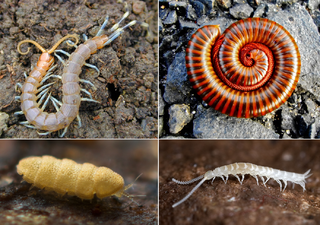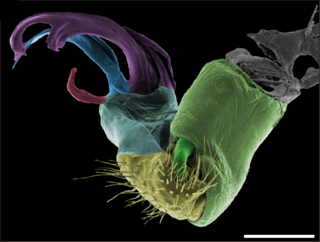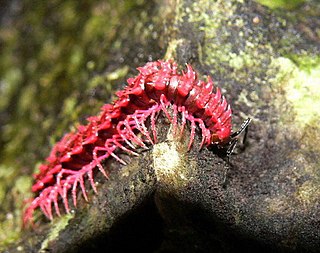
Millipedes are a group of arthropods that are characterised by having two pairs of jointed legs on most body segments; they are known scientifically as the class Diplopoda, the name derived from this feature. Each double-legged segment is a result of two single segments fused together. Most millipedes have very elongated cylindrical or flattened bodies with more than 20 segments, while pill millipedes are shorter and can roll into a tight ball. Although the name "millipede" derives from Latin for "thousand feet", no species was known to have 1,000 or more until the discovery in 2020 of Eumillipes persephone, which can have over 1,300 legs. There are approximately 12,000 named species classified into 16 orders and around 140 families, making Diplopoda the largest class of myriapods, an arthropod group which also includes centipedes and other multi-legged creatures.

Myriapods are the members of subphylum Myriapoda, containing arthropods such as millipedes and centipedes. The group contains about 13,000 species, all of them terrestrial.

Gonopods are specialized appendages of various arthropods used in reproduction or egg-laying. In males, they facilitate the transfer of sperm from male to female during mating, and thus are a type of intromittent organ. In crustaceans and millipedes, gonopods are modified walking or swimming legs. Gonopods may be highly decorated with elaborate structures which may play roles in sperm competition, and can be used to differentiate and identify closely related species. Gonopods generally occur in one or more pairs, as opposed to the single (un-paired) reproductive organs such as the aedeagus of insects or the penis of harvestmen.

Harpaphe haydeniana, commonly known as the yellow-spotted millipede, almond-scented millipede or cyanide millipede, is a species of polydesmidan ("flat-backed") millipede found in the moist forests along the Pacific coast of North America, from Southeast Alaska to California. The dark coloration with contrasting yellow-tipped keels warn of its ability to exude toxic hydrogen cyanide as a defense. The cyanide secretions are not dangerous to humans, but can cause irritation and pain if it contacts sensitive areas such as the mouth, eyes, or nose.

A tergum is the dorsal ('upper') portion of an arthropod segment other than the head. The anterior edge is called the 'base' and posterior edge is called the 'apex' or 'margin'. A given tergum may be divided into hardened plates or sclerites commonly referred to as tergites.

Desmoxytes, whose species are commonly known as the dragon millipedes, is a genus of millipedes of the family Paradoxosomatidae found in Southeast Asia. The genus was described by Ralph Vary Chamberlin in 1923, and reviewed by Sergei Golovatch and Henrik Enghoff in 1994. At least 18 species are known from to Malaysia, Myanmar, and Thailand. One species, D. planata, has also been observed in Sri Lanka, the Andaman Islands, Seychelles, Java, Great Coco Island, and Fiji; however, this species has expanded its range by being transported through human activity. Several species have only recently been discovered, and some have yet to be officially described.

Polydesmida is the largest order of millipedes, containing approximately 3,500 species, including all the millipedes reported to produce hydrogen cyanide (HCN). Polydesmids grow and develop through a series of moults, adding segments until they reach a fixed number in the adult stage, which is usually the same for a given sex in a given species, at which point the moulting and the addition of segments and legs stop. This mode of development, known as teloanamorphosis, distinguishes this order from most other orders of millipedes, which usually continue to moult as adults, developing through either euanamorphosis or hemianamorphosis.

Xystodesmidae is a family of millipedes. Its members often have very small distributional areas, with many species only known from a single locality. They are found across the northern hemisphere, with peak diversity in the Appalachian Mountains, where one-third of the 300 or so species occur. They are particularly abundant in deciduous broadleaf forests in the Mediterranean Basin, Africa, Asia, Central and North America, and Russia. Information on basic taxonomy is scant for this family; for example, it is estimated that the genus Nannaria contains over 200 species, but only 25 were described as of 2006. By 2022, 78 species in Nannaria have been described.

Motyxia is a genus of cyanide-producing millipedes that are endemic to the southern Sierra Nevada, Tehachapi, and Santa Monica mountain ranges of California. Motyxias are blind and produce the poison cyanide, like all members of the Polydesmida. All species have the ability to glow brightly: some of the few known instances of bioluminescence in millipedes.

Richard Lawrence Hoffman was an American zoologist known as an international expert on millipedes, and a leading authority on the natural history of Virginia and the Appalachian Mountains. He was a biology professor at Virginia's Radford College for almost thirty years, and curator of invertebrates at the Virginia Museum of Natural History for another twenty years. He co-founded the Virginia Natural History Society, described over 400 species of millipedes, and produced more than 480 scientific publications. He is commemorated in the scientific and/or common names of over 30 animal species, including the valley and ridge salamander and Hoffman's dwarf centipede.
Brachoria is a genus of polydesmidan millipedes in the family Xystodesmidae inhabiting the Eastern United States. Also known as the Appalachian mimic millipedes, at least 30 species are known, with highest diversity in the Appalachian Mountains, especially the Cumberland Plateau and Ridge and Valley Province.

Xystocheir is a genus of millipedes in the family Xystodesmidae. The genus is endemic to California in the United States, where it is distributed in the Coast Ranges and the Sierra Nevada.

Parafontaria is a genus of "flat-backed" millipedes consisting of 13 species native to Japan, where they are referred to as train millipedes. This is because some species exhibit periodical swarming behavior during which large numbers congregate and can impact train passage when this congregation occurs on tracks. Documentation of this event goes back to 1920. Individuals vary from around 3.5 to 6 cm as adults, and feed on leaf litter as well as soil, making them comparable to earthworms in facilitating decomposition and soil nutrient cycling.

Apheloria tigana, known as the Yellow-and-black flat millipede, is a large North American flat-backed millipede in the family Xystodesmidae. It is reported to secrete cyanide compounds as a defense. It is recommended that one wash hands after handling this organism as the toxic compounds it secretes are poisonous and can cause extreme irritation if rubbed in the eyes.

Apheloria is a genus of flat-backed millipedes in the family Xystodesmidae, occurring in the central and southeastern United States, and ranging as far north as southern Quebec, Canada. They are aposematically colored in black and contrasting reds and yellows, and some species in the Appalachian Mountains resemble species of Brachoria where they co-occur, a phenomenon known as Müllerian mimicry.
Brachoria dentata, the Pennington Gap mimic millipede, is an Appalachian mimic millipede in the Xystodesmidae family.

Pleuroloma flavipes, commonly known as the traveling cherry millipede, is a species of flat-backed millipede in the family Xystodesmidae. It has the widest distribution of any species of xystodesmid millipede and is found in eastern North America from southeastern North Dakota, eastward to Connecticut, and southward to North Carolina, northern Louisiana, and southern Texas. Pleuroloma flavipes millipedes are occasionally observed in large aggregations of individuals where they appear to move en masse in a certain direction, hence the common name "wandering cherry millipede". In a report from 1950, an aggregation of about 6,000 individuals were encountered on a single bridge at McCormick's Creek State Park, Indiana. The species is extremely variable in coloration, and converges in appearance with several species of Apheloria and Brachoria as a result of mimicry.

The genus Nannaria, commonly known as twisted-claw millipedes, is a genus of millipedes in the family Xystodesmidae first described by Ralph Chamberlin in 1918. In 2022, entomologists Derek Hennen, Jackson Means and Paul Marek discovered and described 17 new species, which expanded the size of Nannaria to 78, making it the largest genus of Xystodesmidae.

Heterocladosoma bifalcatum is a common species of millipede found in eastern Australia.

Nannaria swiftae, also known as the Swift twisted-claw millipede or Taylor Swift's millipede, is a species of millipede in the family Xystodesmidae. It is found only in the Appalachian mountains of the U.S. state of Tennessee. It was discovered and described in 2022 by entomologists Derek Hennen, Jackson Means and Paul Marek, who expanded the genus Nannaria to 78 species. They named the species in honor of American singer-songwriter Taylor Swift.

















